Chess Notes
Edward Winter
When contacting us by e-mail, correspondents are asked to include their name and full postal address and, when providing information, to quote exact book and magazine sources. The word ‘chess’ needs to appear in the subject-line or in the message itself.
| First column | << previous | Archives [86] | next >> | Current column |
7249. The name ‘Caro-Kann Defence’
The earliest known occurrences of 1 e4 c6 over the board have already been discussed (see, for instance, C.N. 7017), and the present item focuses on the origins of the name ‘Caro-Kann Defence’.
Max Weiss played 1...c6 four times at Nuremberg, 1883, but the tournament book made no attribution of the move to a particular player or analyst.
On pages 25-26 of the September 1888 Chess Monthly 1...c6 had the following annotation:
‘This move was introduced by the late Herr Kann, of Pest, and adopted in practice by Herr Caro, of Berlin. It gives a safe but dull game.’
The game in question, played in Bradford, was between H.E. Bird and J.H. Blackburne (White) and C. von Bardeleben and M. Weiss. When the score was given on pages 411-412 of the October 1888 BCM there was this note by W.H.K. Pollock:
‘There is nothing to be said against the validity nor anything for the brilliancy of this defence. The Field observes that it was introduced by Herr Kann, of Pesth, and practised by Herr Caro, of Berlin.’
The same material in the BCM was included on pages 78-79 of the Bradford, 1888 tournament book.
On page 271 of the September 1889 International Chess Magazine Steinitz wrote of 1...c6: ‘The late Herr Kann of Vienna introduced this bizarre move into practice among masters.’ A similar remark concerning the same game (Gunsberg v Bauer, Breslau, 1889) appeared on page 289 of the 15 September 1889 issue of La Stratégie: ‘Ce coup est de l’invention de feu M. Kann de Vienne ...’
On page 87 of the March 1891 International Chess Magazine Steinitz made another comment on the origins of 1...c6:
‘This defence was first brought in practice by the late Herr Kann, of Vienna, and afterward analyzed by Herr Caro, of Berlin, who pronounced it a safe line of play for Black.’
The reference books are not always reliable. Page 57 of An
illustrated Dictionary of Chess by Edward R. Brace
(London, 1977) claimed that ‘the opening was named after
H. Caro of Berlin and M. Kann of Vienna, both of whom
played it in the 1890s’. Kann died in 1886. (His death was
noted in two and a half lines on page 128 of the April
1886 Deutsche Schachzeitung, with no mention of
1...c6.) The entry on the Caro-Kann Defence in The
Oxford Companion to Chess stated that the
recommendations of both Caro and Kann appeared in Brüderschaft,
in 1886, whereas in reality the games and analysis of Caro
alone were featured in that magazine, with no mention of
Kann.

Horatio Caro
Pages 202-204 of Brüderschaft, 30 October 1886 had material by Caro in ‘Zur Theorie der Eröffnungen’. The first half of the article, reproduced below, discussed 1 e4 c6 and used the term ‘Caro’s Eröffnung’ in a game between von Bardeleben and Caro played in Berlin earlier that year.
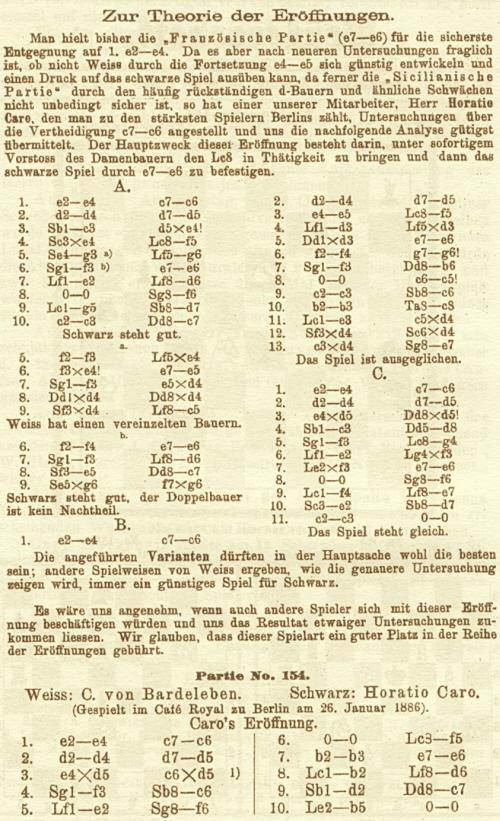
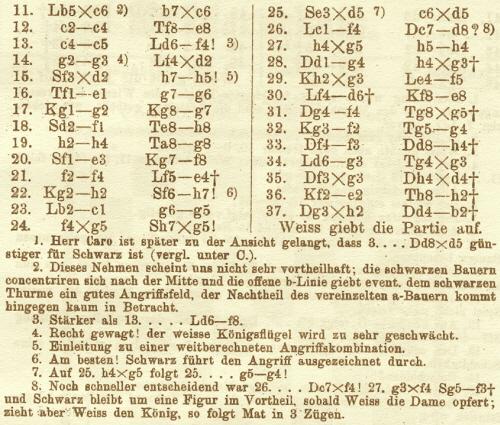
The same heading for the opening appeared on page 219 of the 20 November 1886 issue of the magazine when the game Münchoff v Caro was published:
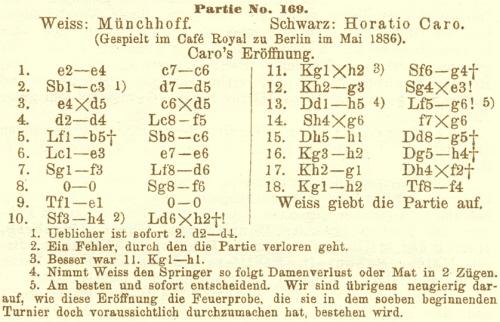
And from page 222 of the 27 November 1886 issue:
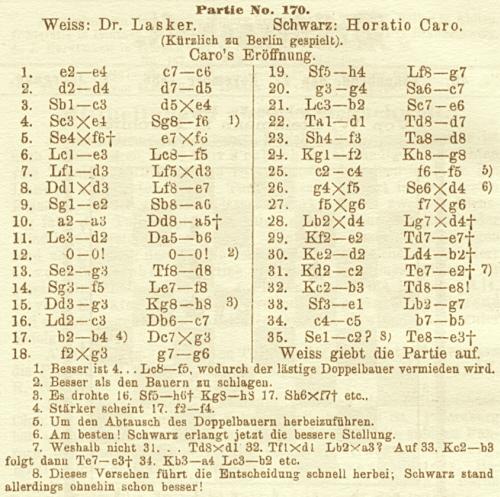
We take ‘Dr Lasker’ to be Berthold Lasker, Emanuel’s elder brother.
In 1887 and 1888 Brüderschaft published a number of games in which Caro played 1...c6 in reply to 1 e4. The heading was invariably ‘Unregelmässige Eröffnung’ (Irregular Opening):
- 1 e4 c6 2 d4 d5 3 e5 Bf5 4 Bd3 Bxd3 5 Qxd3 e6 (F. Riemann v H. Caro, Berlin, September 1886 – pages 24-25 of Brüderschaft, 15 January 1887);
- 1 e4 c6 2 d4 d5 3 exd5 cxd5 4 Bd3 Nc6 5 c3 Nf6 (A. Schottländer v H. Caro, Berlin, September 1886 – pages 32-33 of Brüderschaft, 22 January 1887);
- 1 e4 c6 2 d4 d5 3 exd5 cxd5 4 Nf3 Nc6 5 Be2 Bf5 (E. Schallopp v H. Caro, Berlin, October 1887 – pages 348-350 of Brüderschaft, 15 October 1887);
- 1 e4 c6 2 d4 d5 3 e5 Bf5 4 Bd3 Bxd3 5 Qxd3 e6 (M. Harmonist v H. Caro, Berlin, October 1887 – pages 373-374 of Brüderschaft, 5 November 1887);
- 1 e4 c6 2 d4 d5 3 e5 Bf5 4 Bd3 Bxd3 5 Qxd3 e6 (M. Harmonist v H. Caro, Berlin, April 1888 – pages 142-143 of Brüderschaft, 5 May 1888);
- 1 e4 c6 2 d4 d5 3 Nc3 dxe4 4 Nxe4 Bf5 5 Ng3 Bg6 (G. Irion and S. Tarrasch v H. Caro and M. Kürschner, Nuremberg, August 1888 – pages 372-373 of Brüderschaft, 17 November 1888).
Pages 354-355 of the 22 October 1887 issue had a further article on 1...c6 by Caro:
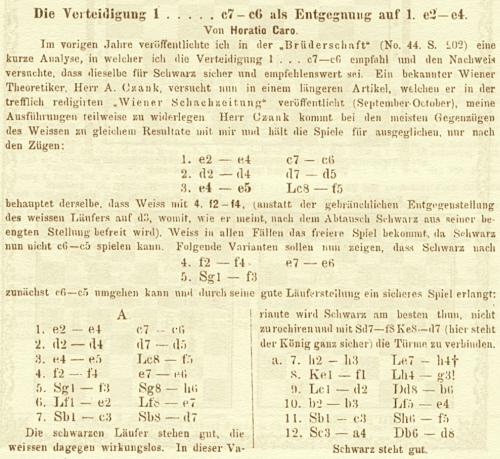
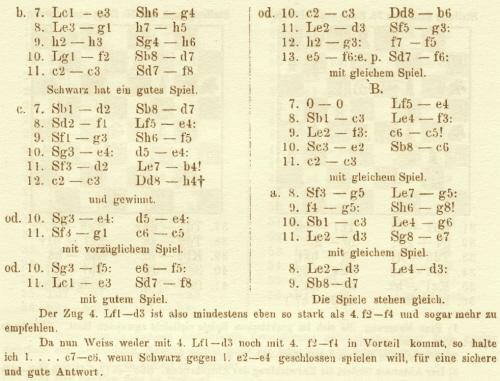
And from page 215 of Brüderschaft, 7 July 1888:

‘Caro-Kann’ as a joint title appeared in an article by Curt von Bardeleben on pages 193-195 of the July 1890 Deutsche Schachzeitung:
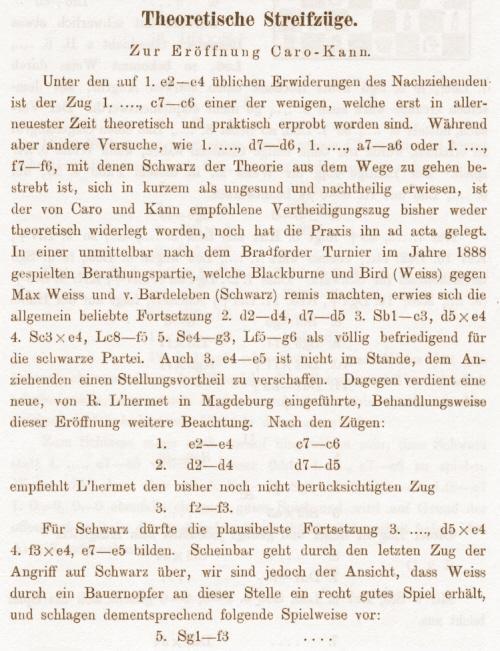
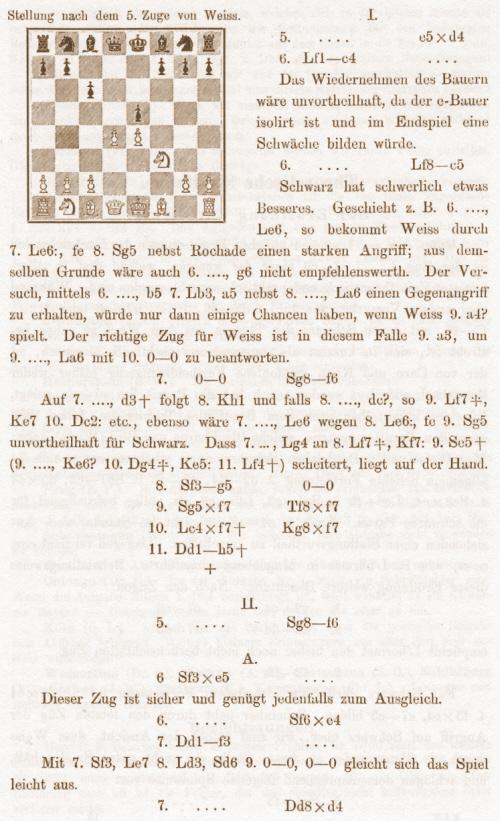

Nonetheless, even in the early years of the twentieth century the term ‘Caro-Kann’ was not always used. For instance, pages 357-358 of La Stratégie, 23 December 1905 gave a cable game between Davidson and Caro. In reply to 1 e4 Caro played 1...c6, but the game was headed ‘Défense Kann’.
What exactly can be demonstrated about Marcus Kann’s contribution to the Caro-Kann Defence?
7250. Horatio Caro
Two more photographs of Caro:

Source: page 443 of the Barmen, 1905 tournament book
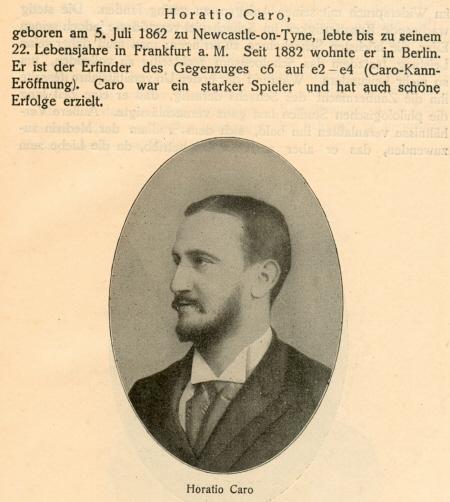
Source: page 353 of the Jubiläums-Ausgabe (1926) of Kagans Neueste Schachnachrichten
Chess Personalia by Jeremy Gaige states that Caro died in London on 15 December 1920. Information about his final years is sought.
7251. The
original signatories of the Fédération Internationale
des Echecs
When the Fédération Internationale des Echecs was founded in 1924 were there 14 signatory countries or 15?
Chess: The History of FIDE reproduced a list of 14 countries from page 201 of the August 1924 issue of La Stratégie:
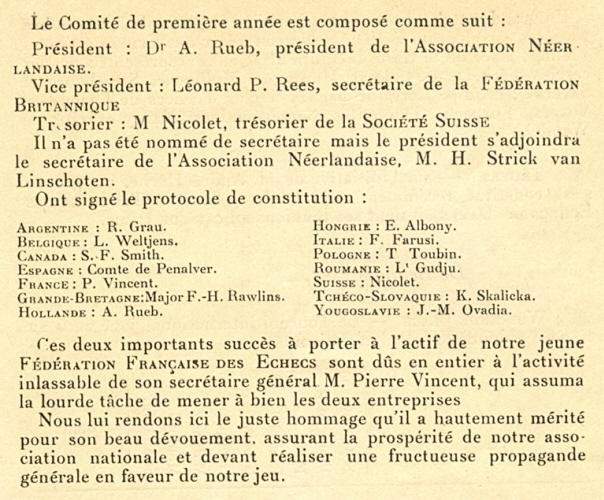
In contrast, and as noted in Chess in 1924, pages 23-24 of Primera Olimpíada de Ajedrez by M.A. Lachaga (Martínez, 1973) listed 15 signatories: Argentina, Belgium, Canada, Czechoslovakia, Finland, France, Great Britain, Holland, Hungary, Italy, Poland, Romania, Spain, Switzerland and Yugoslavia.
The disrepancy has been mentioned by Alfred Maistriaux (Brussels), who asks for further information (e.g. concerning the absence of Finland from the list in La Stratégie).
We note now an official document which compounds the
confusion. On page 3 of the minutes (procès-verbal)
of the Federation’s second congress (Zurich, 22-26 July
1925) the FIDE President, Alexander Rueb, listed the
original signatories, stating that the total had been 15:
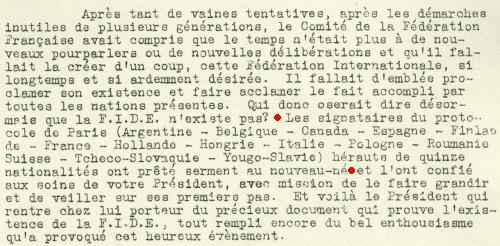
It will be remarked, however, that only 14 countries were named, with Finland among them. Great Britain was omitted, evidently by mistake. (S.J. Holloway and V.L. Wahltuch had been listed on page 1 as Great Britain’s representatives in Zurich.)
It might therefore be tempting to assume that the correct figure for the year 1924 is indeed 15 and that the omission of Finland by La Stratégie was an error. However, page 1 of the procès-verbalstated that before the 1925 Zurich Congress ended two new FIDE members declared themselves, and one of them was Finland:
‘Avant clôture du Congrès ont annoncé leur adhésion:
Correspondence Chess League of America
Finlande.’
7252. Capablanca and his daughter
From our archives comes this photograph of Capablanca
with his daughter Gloria (circa 1941):
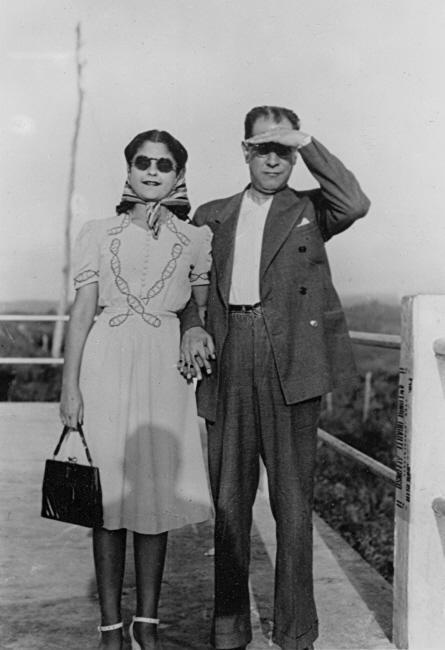
7253. Laroche
(C.N. 6693)
From Dominique Thimognier (Fondettes, France):
‘Further to your correspondent’s question in C.N. 6693 about two individuals named Laroche, I have investigated their identities and presented the results on my Héritage des échecs français website.
Laroche “de Bayonne” was Jean Adolphe Laroche (who may have been known as just Adolphe Laroche in day-to-day life), born on 10 May 1811 in Bayonne and died on 25 March 1866, also in Bayonne.
“Doctor” Laroche was Pierre François Laroche, born in Montagney on 14 September 1793 and died on 30 June 1850 in Villevaudé. There is still a slight doubt as to his identity since his death-date does not match the date specified in his death notice on page 225 of Sphinx, August 1850 (which gave 6 July).
It is difficult to say which Laroche was featured in Marlet’s famous painting.
The Félix de Laroche who appears on a list of members of the Cercle des Echecs de Paris (La Régence, 1851) was a minor club member. Finally, as regards the brother of Laroche de Bayonne nothing indicates in the text published in La Régence that he played chess. It seems that he merely accompanied his brother on his journey to London with Kieseritzky.’
7254. Stalemate
- From page 63 of Invisible Moves by Y. Afek and E. Neiman (Alkmaar, 2011):
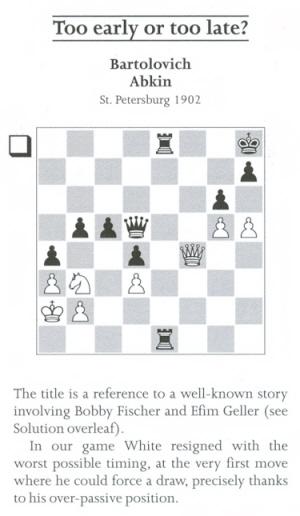
- From page 77 of Blunders and Brilliancies by I. Mullen and M. Moss (Oxford, 1990):

- From page 7 of the March 1982 Chess Life (feature by A. Soltis):

- From page 41 of Chess Techniques by A.R.B. Thomas (London, 1975):

- From page 364 of Chess Review, December 1962 (article by W. Korn):
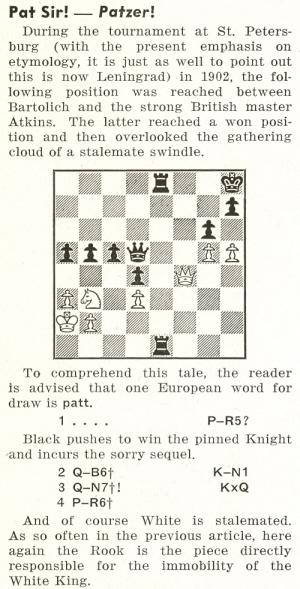
- From page 72 of The Art of Chess Combination by E. Znosko-Borovsky (London, 1936):
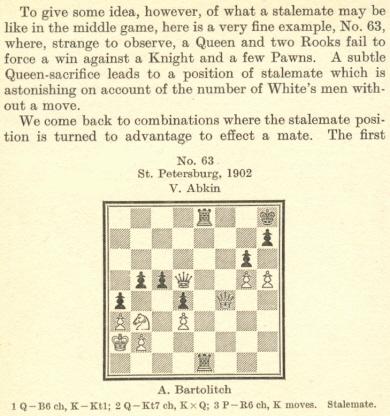
- From page 216 of the July 1902 Deutsche Schachzeitung:
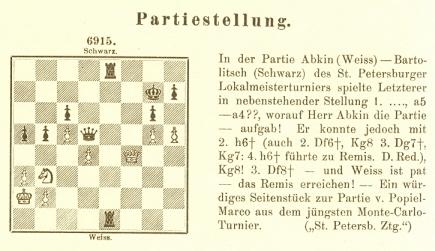
Thus the players’ names are variously given as Bartolovich, Bartolish, Bartolitsch, Bartolich, Bartolitch and Abkin, Atkin and Atkins.
The earliest version, from Deutsche Schachzeitung, mentions a source (‘St Petersb. Ztg’), but can the relevant issue of that newspaper be traced?
As regards the occasion of the game, the crosstable of a tournament played in St Petersburg, 1902 is on page 187 of volume two of Chess Tournament Crosstables by J. Gaige (Philadelphia, 1971). Abkin and Bartolich were participants, and Abkin lost their individual game. That corresponds to the Deutsche Schachzeitung version, which states that Abkin was White. It is also the only version to have a different configuration for the queen’s-side pawns.
7255. A strange claim about Kashdan
From page 38 of Blunders and Brilliancies by Ian Mullen and Moe Moss (Oxford, 1990):
‘The late Isaac Kashdan who, in the 1920s and 30s, was Alekhine’s heir apparent ...’
7256. Marcus Kann (C.N. 7249)
C.N. 7249 concluded with a question: ‘what exactly can be demonstrated about Marcus Kann’s contribution to the Caro-Kann Defence?’
Per Skjoldager (Fredericia, Denmark) draws attention to the note to 1...c6 on page 321 of the Carlsbad, 1907 tournament book by Marco and Schlechter:
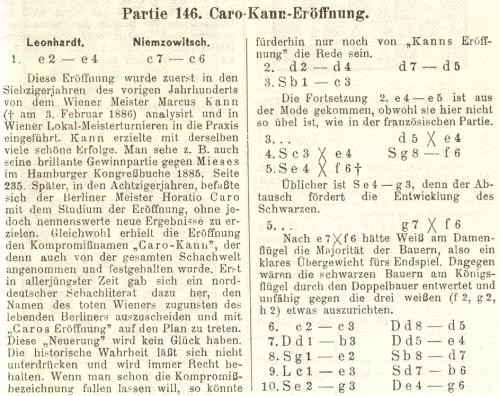
For an English version, by Robert Sherwood, see pages 339-340 of the translation published by Caissa Editions in 2007.
Below is the Mieses v Kann game from page 235 of the Hamburg, 1885 tournament book:
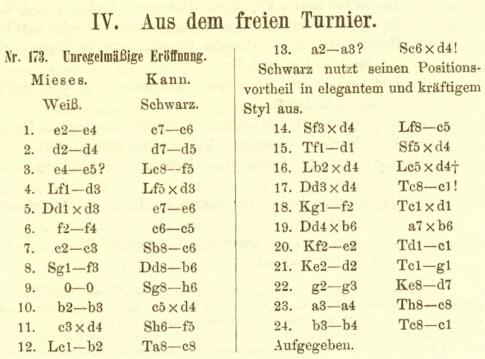
Eduardo Bauzá Mercére (New York, NY, USA) observes that Kann’s obituary on page 81 of Österreichische Lesehalle, March 1886 made no mention of any particular contributions to chess theory:

Mr Bauzá Mercére has also forwarded a game (played in the Turnier der Wiener Schach-Gesellschaft) from pages 74-76 of the May 1881 Österreichische Lesehalle:
Marcus Kann – Alexander WittekVienna, 2 April 1881
Irregular Opening
1 Nc3 e5 2 g3 d5 3 e3 Be6 4 d4 exd4 5 Qxd4 Nf6 6 Bd2 Be7 7 h4 Qd7 8 Nf3 c5 9 Qf4 Bd6 10 Qg5 Nc6 11 Qxg7 Ke7 12 e4 Rag8 13 Qh6 Rg6 14 Qe3 d4 15 Qe2 dxc3 16 Bxc3 Nd4 17 Qd3
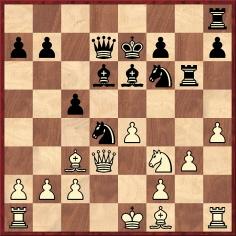
17...Bc4 18 Qd1 Bxf1 19 Kxf1 Ng4 20 Nxd4 cxd4 21 Qxd4 Qb5+ 22 Qd3 Qxd3+ 23 cxd3 Rd8 24 d4 Rf6 25 f4 Bxf4 26 gxf4 Rxf4+ 27 Ke2 Rxe4+ 28 Kf3 f5 29 Rae1 Nf6 30 Rxe4+ fxe4+ 31 Kf4 Rg8 32 Ke5 Re8 33 Rf1 Kf7+ 34 Kd6 Re6+ 35 Kc7 Re7+ 36 Kb8 Ke6 37 Rf4

37...e3 38 Kxa7 Rc7 39 Rf1 Nd5 40 Kb8 Rg7 41 Re1 Kf5 42 Ba5 Ke4 43 Bd2 Kxd4 44 Rxe3 Rg8+ 45 White resigns.
Our correspondent adds:
‘Kann’s forename is spelled Markus in the heading to the game, as well as on page 49 of the February 1884 magazine and page 145 of the May 1884 issue.’
7257. Detroit, 1933
A group photograph from the Western Chess Association tournament, Detroit, 1933:
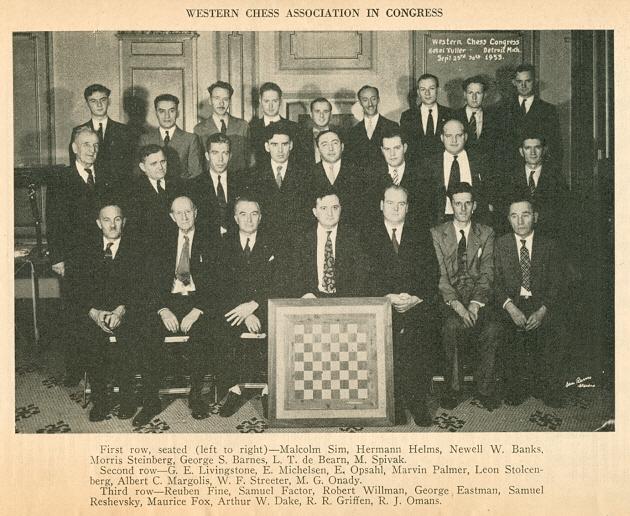
Source: American Chess Bulletin, September-October 1933, page 128.
7258. German game (C.N.s 6941 & 7093)
From Thomas Niessen (Aachen, Germany):
‘C.N.s 6941 and 7093 reported on suggestions that the Evans Gambit and Ruy López should be renamed the “German Game”, and I now note the following on page 423 of the eighth edition of von Bilguer’s Handbuch des Schachspiels (Berlin and Leipzig, 1922):
“v.d. Lasa spricht sich in der D. Schachz. 1873, S. 163 gegen die Bezeichnung ‘Spanische Partie’ aus und erklärt, die Eröffnung müsse ‘Deutsche Partie’ benannt werden, weil fast ihre gesamte Entwicklung das Werk deutscher Forscher sei. Cordel hat in seinem letzten Werk Theorie u. Praxis des Schachspiels (I, S. 4) die Umtaufe vollzogen. Deutschen Meistern gebührt das Verdienst, eine gute und zum Ausgleich genügende Verteidigung gefunden zu haben. Vor einem Jahrzehnt noch eine fürchterliche Waffe in der Hand von Großmeistern wie Tarrasch, Lasker u.a., hat die spanische Partie dank der Forschungen deutscher Meister heute ihre Schrecken verloren.”
To summarize, the Handbuch remarked that on page 163 of the 1873 Deutsche Schachzeitung von der Lasa had expressed opposition to the name “Ruy López”, believing that “German Game” would be correct for the opening because of the work of German researchers. Cordel used that name in his book Theorie und Praxis des Schachspiels. Only a decade ago, the Handbuch stated, the opening had been a terrible weapon in the hands of such masters as Tarrasch and Lasker, but it was now less feared, owing to the work of German researchers.’
Below is page 163 of the June 1873 Deutsche Schachzeitung (part of an obituary of Jaenisch written by von der Lasa):
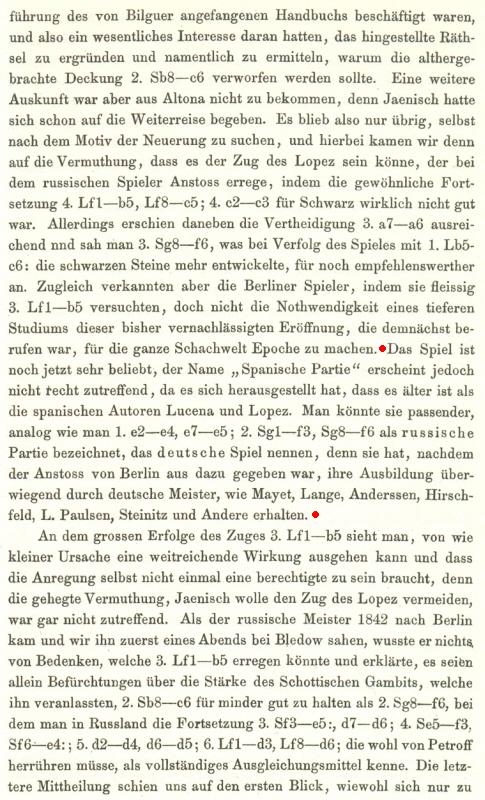
7259. A strange claim about Kashdan (C.N. 7255)
Michael Clapham (Ipswich, England) draws attention to a passage on page 58 of Championship Chess by P.W. Sergeant (London, 1938):
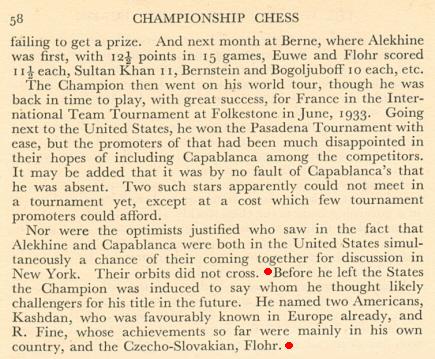
(In the first paragraph the chronology is confusing, the Pasadena tournament having taken place in 1932.) As regards the comment about Kashdan, Fine and Flohr at the end of the second paragraph, we add the following from page 477 of the November 1933 BCM:
‘United States. – Dr Alexander Alekhine, before leaving New York for Europe on 5 [sic] September, told an interviewer that he regarded as specially likely future opponents Kashdan, Fine and Flohr, with the first-named the most probable. “America’s chances of possessing the next champion”, he said, “are excellent”.’
A correction appeared on page 527 of the December 1933 BCM:
‘In our first paragraph under the heading United States last month (page 477) the words “the first-named” should have been “the two first-named”, as Dr Alekhine included Reuben Fine with Isaac Kashdan in his choice of most probable future challengers for the world championship. He is said, indeed, to have described Fine as “a real threat” for the title.’
More information about the interview is sought.
Around the same time, Alekhine was interviewed by Kashdan himself, on pages 9-10 of the September 1933 Chess Review (see C.N. 5631). Alekhine was asked about US masters, but no names were mentioned in his reply:
‘We wanted to know what he thought of the American players, and how they compared with the younger European stars. “Your double success in the International Team Tournaments has put America in the first rank among the chessplaying nations. No other country has so many promising young masters. In New York City alone you have at least a dozen young men who have nothing to fear from the leaders of any country in Europe. I predict many new successes, and you have enough talent developing to keep in the top flight indefinitely.”’
7260. Another Alekhine interview
Another interview with Alekhine, by Lucien Zacharoff, was printed on page 7 of the Brooklyn Daily Eagle, 19 May 1929. A copy has been received from John Blackstone (Las Vegas, NV, USA):
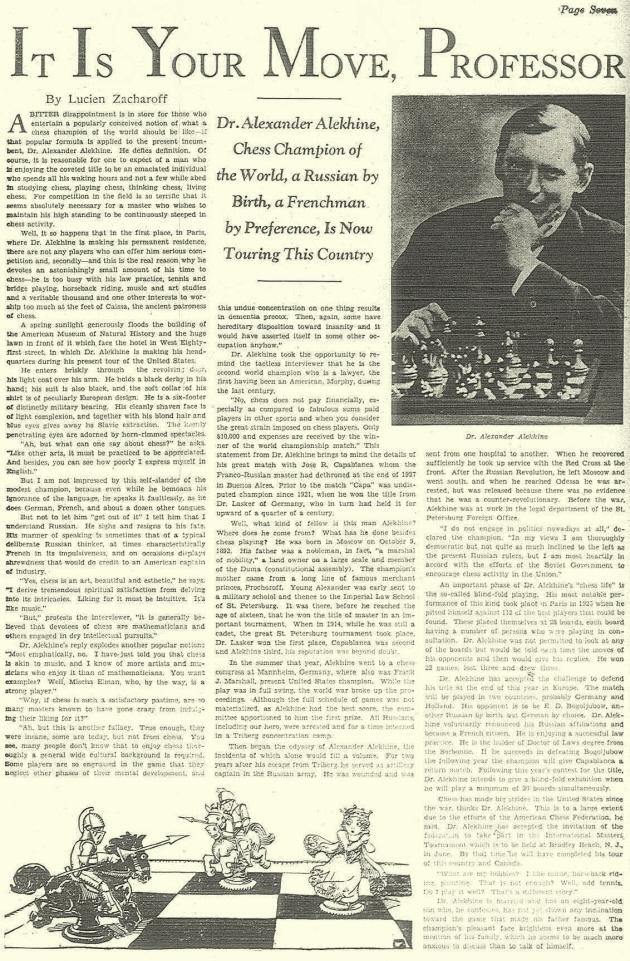
From Alekhine’s observations we highlight these:
- ‘Yes, chess is an art, beautiful and esthetic ... I derive tremendous spiritual satisfaction from delving into its intricacies. Liking for it must be intuitive. It’s like music.’
- (Asked why so many masters are ‘known to have gone crazy’ from indulgence in chess.) ‘Ah, but this is another fallacy. True enough, they were insane, some are today, but not from chess. You see, many people don’t know that to enjoy chess thoroughly a general wide cultural background is required. Some players are so engrossed in the game that they neglect other phases of their mental development, and this undue concentration on one thing results in dementia precox. Then, again, some have hereditary disposition toward insanity and it would have asserted itself in some other occupation anyhow.’
- ‘I do not engage in politics nowadays at all ... In my views I am thoroughly democratic but not quite as much inclined to the left as the present Russian rulers, but I am most heartily in accord with the efforts of the Soviet Government to encourage chess activity in the Union.’
- ‘What are my hobbies? I like music, horseback riding, painting. That is not enough? Well, add tennis. Do I play it well? That’s a different story.’
7261. Gheorghiu v Quinteros
Richard J. Hervert (Aberdeen, MD, USA) raises the subject of this game on page 128 of the first edition of The Oxford Companion to Chess by D. Hooper and K. Whyld (Oxford, 1984):
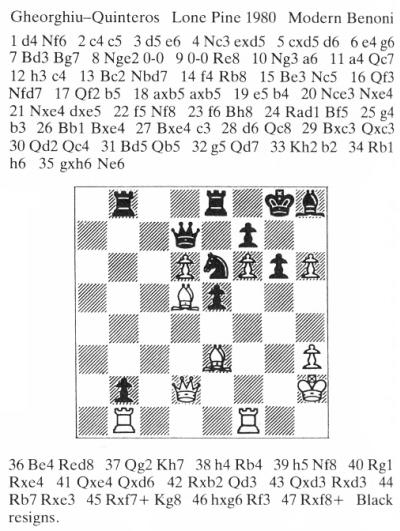
After observing that 20 Nce3 should read 20 Nce4 and that White’s 29th move was bxc3, and not Bxc3, our correspondent remarks that according to the crosstable for Lone Pine, 1980 (available in various publications, including page 23 of the August 1980 Chess Life), Quinteros defeated Gheorghiu with the white pieces in that tournament (round two).
The Argentinian’s victory (which began 1 d4 Nf6 2 c4 c5 3 d5 e5 4 Nc3 d6 5 e4 Be7 6 Bd3 Nbd7 7 Nge2 h5) is available in databases. So too is the above Gheorghiu v Quinteros game, which, Mr Hervert adds, Gheorghiu annotated on page 68 of Informator 29. The heading was not ‘Lone Pine, 1980’, but merely ‘USA 1980’.
Since it can hardly be doubted that Quinteros defeated Gheorghiu in the 1980 Lone Pine tournament, the main question now concerns the occasion of Gheorghiu’s (‘USA 1980’) victory over Quinteros.
7262. Maróczy v Korchnoi (C.N.s 5411 & 5417)
With regard to the Maróczy v Korchnoi ‘spiritualist’ game, C.N. 5417 mentioned the coverage in the Icelandic daily newspaper Tíminn. We are grateful now to Baldur Fjölnisson (Reykjavik) for sending those reports:
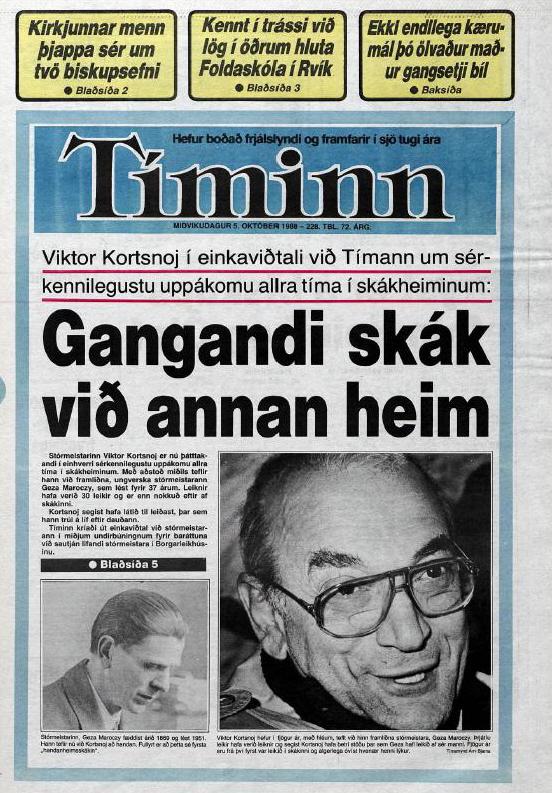
5 October 1988, page 1, page 5. 6 October 1988, page 5.
Mr Fjölnisson comments:
‘In the interview Korchnoi does not really say much about the game. Interestingly though, he states that Maróczy dropped a piece in the middle-game, which contradicts the game-score as widely published. Otherwise the story is broadly in line with accounts available on the Internet. At the time, in 1988, 30 moves had been played according to Korchnoi.’
7263. Botvinnik on his predecessors
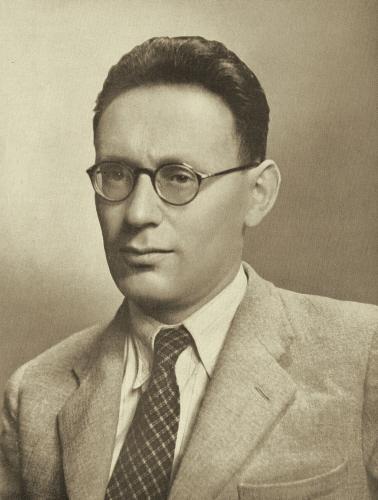
Mikhail Botvinnik
Writers on Mikhail Botvinnik tend to pass over a significant article which he contributed to International Championship Chess by B. Kažić (London, 1974). Published on pages 244-250, it is entitled ‘Botvinnik on his Meetings with World Champions’ and discusses Lasker, Capablanca, Alekhine and Euwe. An observation from page 248:
‘Alekhine’s was a complex character. As soon as he felt any signs of hostility, he would shoot out his quills like a porcupine. When people were kind he felt bound to behave in the same way.’
We should like to know whether Botvinnik’s original text is available, since the English version is sometimes defective. For example, page 247 has the following regarding AVRO, 1938:
‘The tournament marked the greatest in Capablanca’s entire career.’
A word such as ‘failure’ or ‘disappointment’ seems to be missing after ‘greatest’.
There is an interesting passage on pages 246-247, concerning the period after Hastings, 1934-35:
‘At the invitation of S.O. Weinstein, Capablanca came to the Soviet Embassy in London and immediately agreed to play in Moscow. It was a while before Capablanca actually came. Weinstein inconsiderately asked him about a possible match with Alekhine and suddenly the Cuban changed colour! He glared and could not calm down for a long time. Capablanca and Alekhine remained enemies for the rest of their lives.
Capa was phenomenal at calculating positions, but he was also a shrewd tactician. At the tournament in Moscow I played Black and skilfully brought the game to even play, when, unexpectedly, Capablanca in the end “overlooked” a man!? But – no! White had, in fact, been preparing a quiet move and a variation in which he actually took the pawn. All of this was artfully concealed.’
The description appears to concern the play in connection with Capablanca’s move 19 Rxa7 against Botvinnik in the Moscow, 1935 tournament, with the curious variation featuring 22 Kf1. Below is the relevant part of the tournament book (page 135), with notes by Ilya Rabinovich:
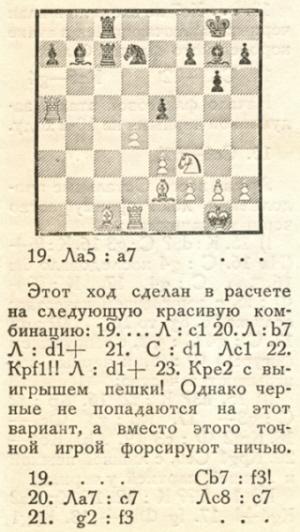
See too pages 92-93 of the English edition of the tournament book (Yorklyn, 1998). Botvinnik’s own notes appeared in the first volume of his Best Games series; for instance, on pages 181-183 of the English edition (Olomouc, 2000).
Three photographs taken during the game come to mind. The first was published opposite page 216 of Homenaje a José Raúl Capablanca (Havana, 1943) and opposite page 16 of Botwinnik lehrt Schach by H. Müller (Berlin-Frohnau, 1967):
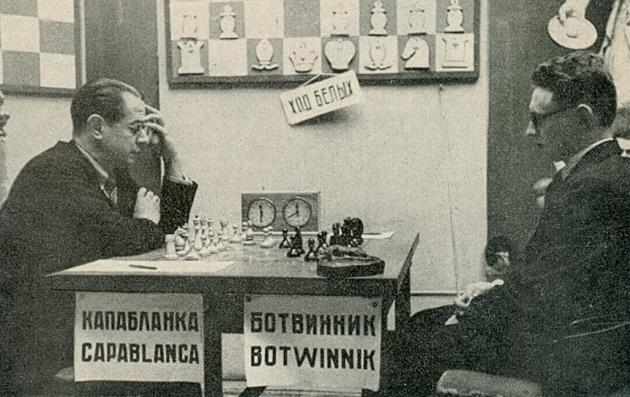
Next, there is a shot included in the plate section of Botvinnik’s autobiography K Dostizheniyu Tseli (Moscow, 1978):
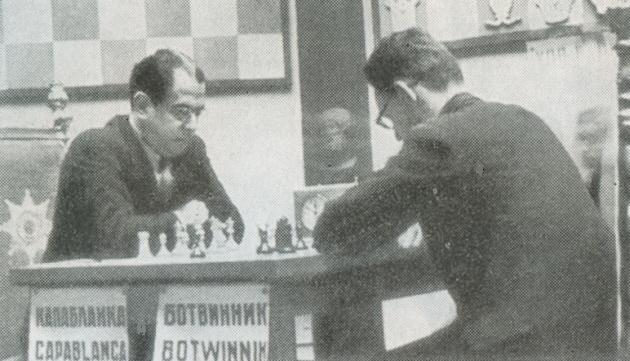
A third photograph may be viewed on-line at the RIA Novosti website.
Botvinnik’s autobiography (page 51) mentioned the game, stating that he arrived ten minutes late because he had forgotten his glasses. That passage is on page 42 of the English translation, Achieving the Aim (Oxford, 1981).
7264. Robert G. Wade
Ross Jackson (Raumati South, New Zealand) sends a photograph of Robert Wade holding the New Zealand championship trophy:

A relative of Wade’s provided the picture to our
correspondent. Wade won the New Zealand championship in
1943-44 (Wellington), 1944-45 (Auckland) and 1947-48
(Dunedin). The exact place and date of the photograph are
uncertain, although Wellington is regarded as the probable
location.
7265. Stalemate (C.N. 7254)
Concerning the Abkin v Bartolich ending, Vitaliy Yurchenko (Uhta, Komi, Russian Federation) draws attention to page 153 of Шахматное обозрение, March, April and May 1902:
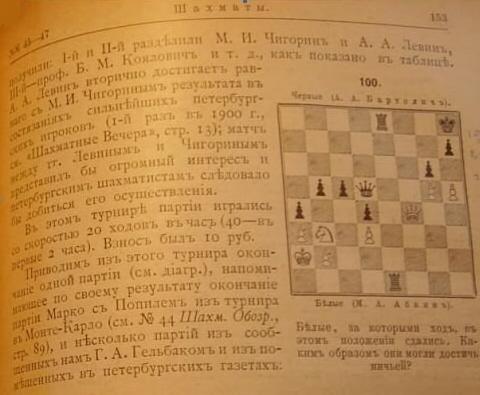
Mr Yurchenko comments that the same configuration of queen’s-side pawns was given on page 102 of Шахматный журнал, April 1902.
7266. Moscow, 1935
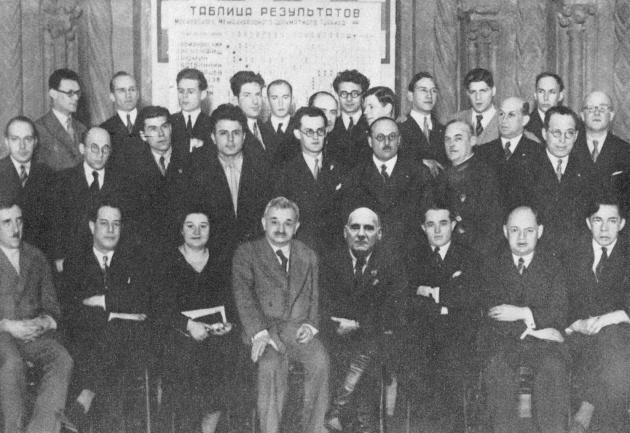
Regarding this group photograph of Moscow, 1935, is it possible to fill in any of the gaps in the caption published on page 191 of the Caissa Editions tournament book mentioned in C.N. 7263?

7267. Reykjavik, 1972
Concerning these two items in his possession, Ríkharður Sveinsson (Reykjavik) wonders how many signatures it is possible to identify.
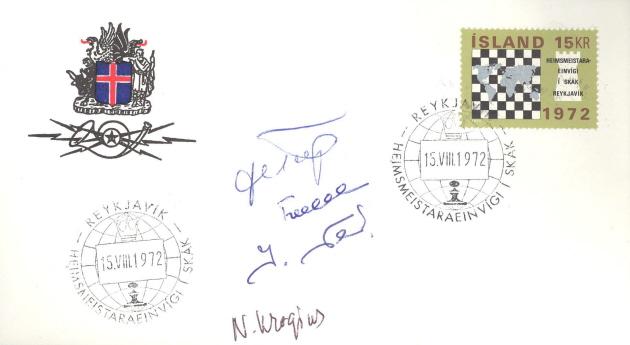
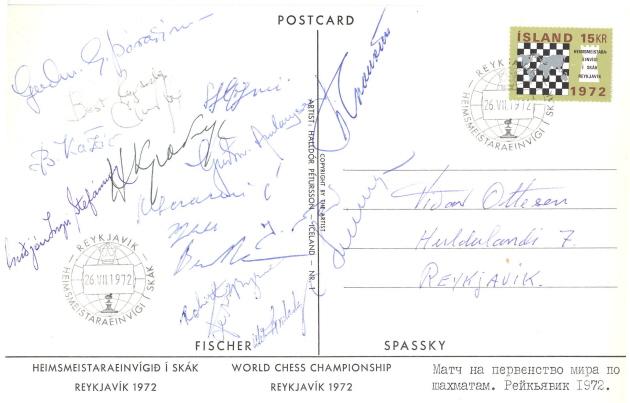
7268. Cartoons (C.N. 3938)
From page 36 of Tom Webster’s Annual 1922 (London, 1922):
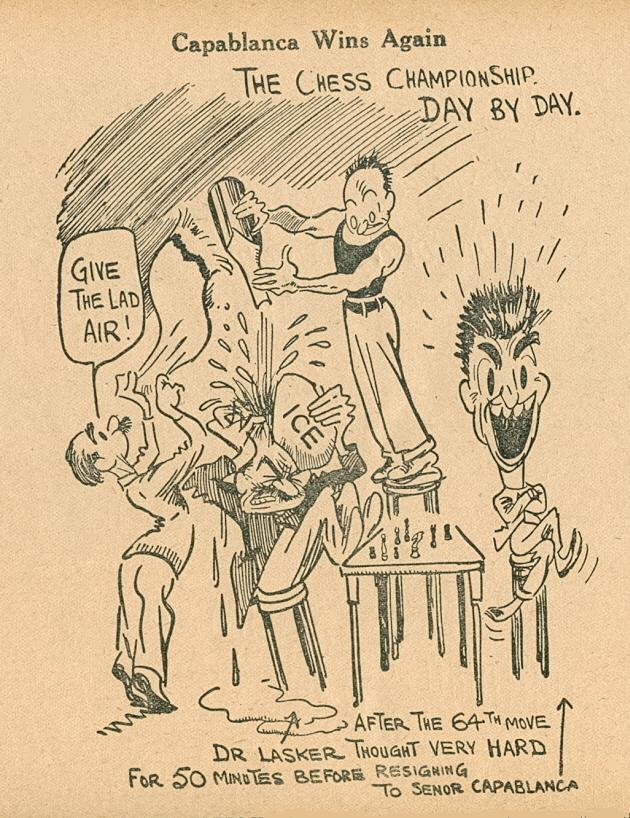
7269. Robert G. Wade (C.N. 7264)
Knud Lysdal (Grindsted, Denmark) asks whether the second forename of Robert G. Wade is known for certain. He remarks that Jeremy Gaige’s Chess Personalia has Graham, whereas in a ChessBase article dated 30 November 2008 David Levy wrote:
‘Incidentally, Bob’s middle name was Grant, not Graham. I know it is given as Graham in some sources but he told me it was Grant.’
Evidence in support of either name is sought. We note his entry on page 240 of Who’s Who in New Zealand (Wellington, 1951):

7270. Wade v Bennett
With regard to the Wade v Bennett game, on 28 July 1995 we received the following from Robert Wade:
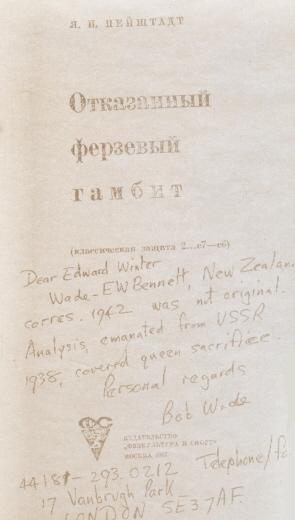
7271. Walter Grimshaw (1832-90)
Michael McDowell (Westcliff-on-sea, England) sends a photograph, taken by Steve Mann, of Walter Grimshaw’s gravestone in the Larpool Lane Cemetery, Whitby, England:
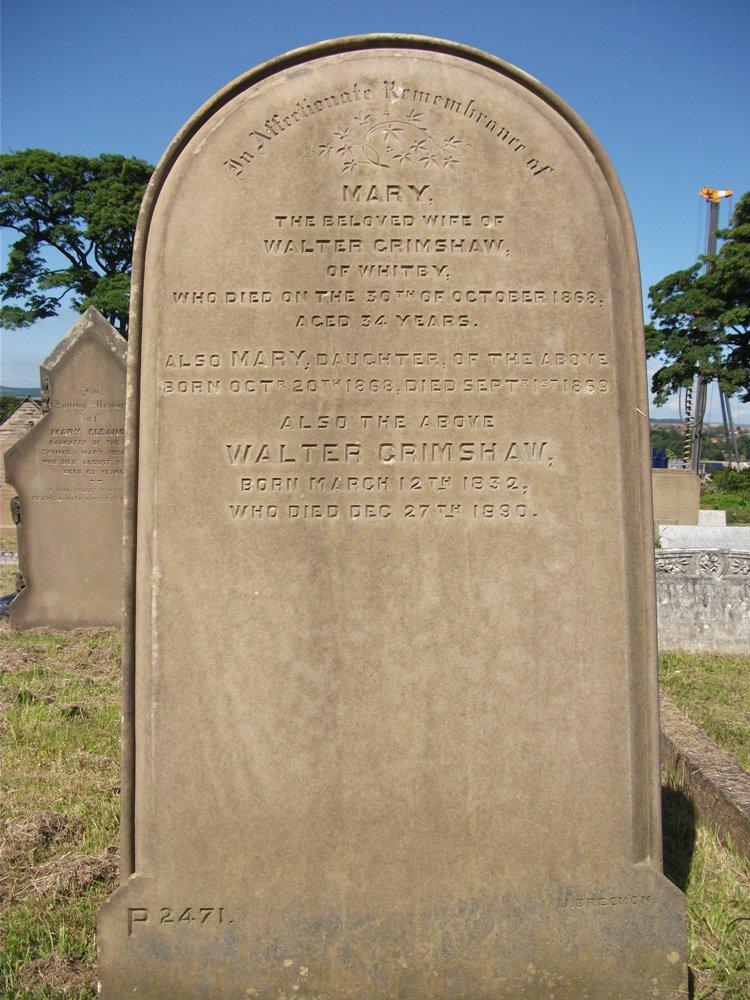
A note by Mr Mann:
‘The original interment was of Walter Grimshaw’s first wife, Mary, whom he had married in York (St Crux) on 10 October 1861. She died soon after giving birth to their second child, Mary, who died within a year. Earlier, Walter and Mary had had a son, Walter Edwin Grimshaw, who survived his father. The latter’s second wife was the widow Jane Trattles, of the ship-owning company Trattles. They married on 18 May 1878 at Whitby parish church.’
On 27 December 1890 Grimshaw committed suicide by cutting his throat with a razor. Mr McDowell has sent us the lengthy account published on page 5 of the Whitby Times, 2 January 1891.
The photograph referred to in the Whitby Times is reproduced below (the frontispiece to the January 1886 BCM):


A further photograph of Grimshaw was published opposite page 41 of the February 1891 BCM:
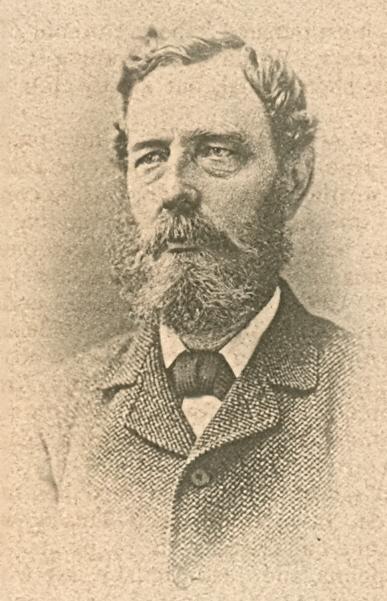
As regards the Grimshaw theme (reciprocal interferences between two pieces of unlike motion), Mr McDowell notes that Grimshaw’s famous problem first appeared in the Illustrated London News of 24 August 1850:
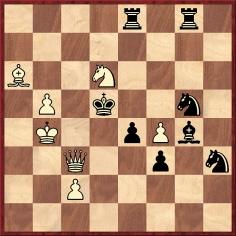
Our correspondent adds:
‘The first edition of the Oxford Companion to Chess (page 134) gives the correct publication year of the problem (1850), while the second edition (page 99) gets it wrong.’
We note the following in the entry on the Grimshaw theme on pages 172-173 of the Dictionnaire des échecs by F. Le Lionnais and E. Maget (Paris, 1967):
‘Le problème souche est attribué à Walter Grimshaw (mais il est en réalité de Brede qui avait fait apparaître, sans s’en rendre compte il est vrai, une “Interception Grimshaw”, en 1844, dans une variante secondaire. Grimshaw, en 1850, composa délibérément le premier problème sur ce thème).’
Henry E. Kidson wrote about Grimshaw in ‘Some reminiscences of a noted problem composer’ in the Yorkshire Weekly Post, an article which was reproduced on pages 38-39 of Lasker’s Chess Magazine, November-December 1906. Grimshaw and Kidson both appear in a photograph (Redcar, 1866) given in C.N. 5614.
7272.
Alleged demolishment of Steinitz
From page 115 of The Golden Treasury of Chess by Francis J. Wellmuth (Philadelphia, 1943):
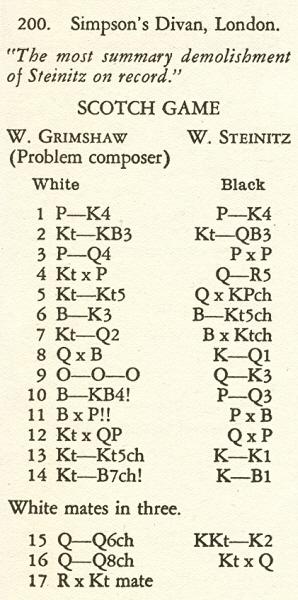
We can add that the ‘most summary demolishment’ quote was taken from page 81 of The Chess Players’ Compendium by William Cook (Bristol, 1902). Above all, however, it should be noted that Steinitz strenuously denied having lost such a game, describing it as bogus and a fraud. See our new feature article Grimshaw v Steinitz.
7273. Buenos Aires, 1939
Christian Sánchez (Rosario, Argentina) has compiled a webpage of team photographs taken during the 1939 Olympiad in Buenos Aires, the source being La Nación of 3 September 1939.
Our correspondent would welcome assistance with gaps in players’ full names:
‘Examples are A. Larsen (Norway) and C. Waegemans Stoffels (Belgium), who is also known as Marianne Stoffels. Felipe Pinzón (Peru) appears with two different maternal surnames (Solís and Sánchez) The maiden name of María A. de Vigil (Uruguay) is not known.
Then there is a long list of players whose middle name is not given. To mention only those where an initial is available: Luis V. Zabala (Bolivia), Ernst C. Sørensen (Denmark), Santiago U. Morales Ceballos (Ecuador), Christiaan (F.?) de Ronde (Holland), Sverre (M.?) Rebnord (Norway), Alfredo F. Olivera (Uruguay), Ernesto J. Rottuno (Uruguay) and Luis L. Roux Cabral (Uruguay).’
7274. Robert G. Wade (C.N. 7269)
Simon Spivack (London) has forwarded us his appreciation of R.G. Wade, which includes a reference to the ‘Graham or Grant?’ question and shows two pages of Wade’s passport. We are grateful to Mr Spivack for permission to reproduce those pages here:
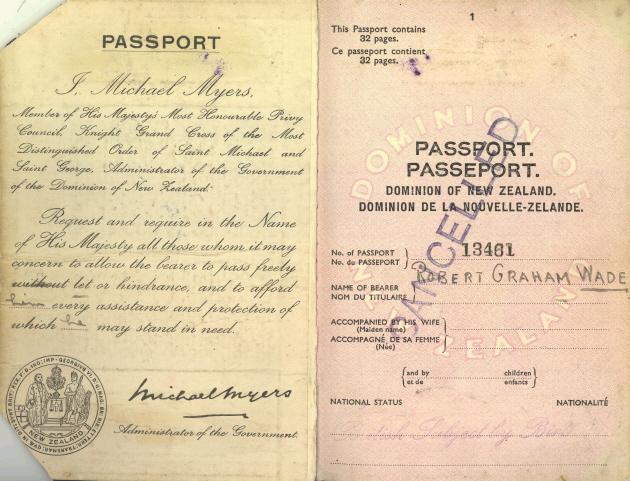
7275. Missing son
From Olimpiu G. Urcan (Singapore) comes this feature concerning ‘Boris Bogoliubov’ from page 9 of the Cleveland Plain Dealer, 13 December 1925:
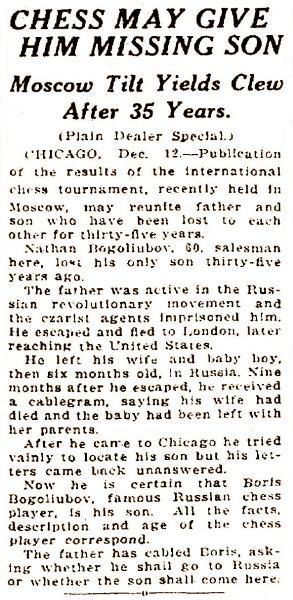
7276. Eng and Chang (C.N.s 3434 & 5928)
Mr Urcan has also submitted an item on page 3 of the features section of the Dallas Morning News of 27 April 1930:

7277. Application by Horwitz
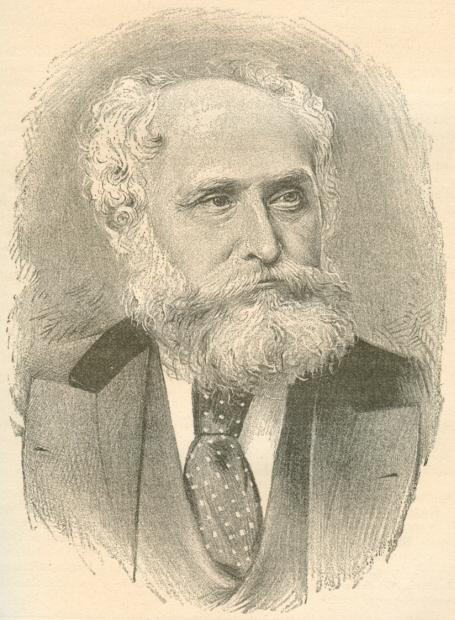
Bernhard Horwitz (1807-1885) on page 65 of the November 1890 Chess Monthly
Hans Renette (Bierbeek, Belgium) has found an application by Bernhard Horwitz for support from the Royal Literary Fund. The documentation is in the Manuscripts Department of the British Library (St Pancras, London), with the reference number Loan 96 RLF 1/1904. The material consists of Horwitz’s completed application form, an explanatory letter and two letters of support.
On the application form, dated 15 October 1872, Horwitz stated that he was an ‘artist’ by profession, born in 1807 and single. His ‘means of income’ was ‘occasional Chess Contribution, Chess Lessons and Painting’. On the front of the application form the following, dated 13 November 1872, was written: ‘No literary claim.’
Below is Horwitz’s letter of application:
‘3 Francis Street
Tottenham Court Road15 October 1872
My Lords and Gentlemen,
Unfortunate circumstances compel me to ask assistance of your Society, so excellent in its objects.
I am a German and a literary man, and have now resided in this country for nearly 26 years. I have all this time supported myself by giving chess lessons, by taking portraits and by contribution to various foreign and English periodicals. I am sorry to say that lately through circumstances, over which I had no control, I have had but little to do and that I have been in somewhat feeble health, as that I have found myself in some severe difficulties, and have had to part with very many of my properties. I need I hope but little help to recover my losses, and to restore my peace of mind and it is for this that I now venture to make application to your admirable Society. I was well known to the late Prince Albert, who subscribed to my first Chess work. I can explain more in detail if needed, the nature of my mishaps, and the causes of misfortune.
I am, my Lords and Gentlemen,
Your obedient servant,
B. Horwitz.’
7278. Horrwitz/Horwitz/Harrwitz bishops
A detailed article on this hoary subject (and it is, of course, even possible to find the term ‘Horowitz bishops’) was written by Peter Gütler on pages 42-43 of the 2/1999 issue of Kaissiber.
7279. Signed chess books
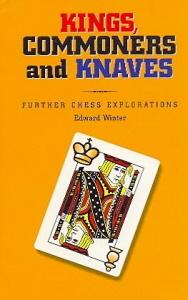
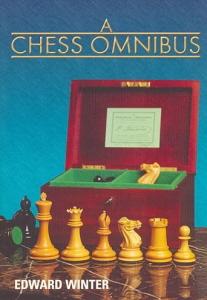

Inscribed copies of our books are still available, and until the end of this month any reader who buys two or more items from our Signed Chess Books page will receive a complimentary copy of volume two of G.H. Diggle’s Chess Characters, also inscribed by us. If four or more items are ordered, a second gift will be the rarely seen 54-page work Fragen der Zeit: Politik, Schach und die Grenzen menschlicher Leistungsfähigkeit by Garry Kasparov (Zurich and Geneva, 1999).

As if such largesse were not enough, for five days only (i.e. until 25 September 2011) signed copies of the 2011 edition of our Capablanca book can be ordered from us for $25, instead of the standard price of $35. Only one copy per reader may be bought at this special rate.
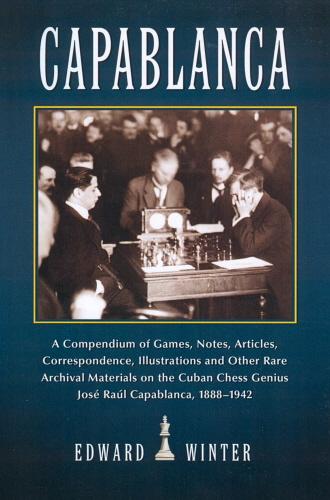
7280. No fuss
William Hartston (Cambridge, England) sends this report from the Beachcomber column on page 8 of the Daily Express, 15 August 1935:
‘Bon Voyage!
Two days ago the English chess team left London for Warsaw to play in the international tournament.
There was no fuss. Indeed, a famous chess player is about the only person in modern life who is not mobbed on sight. If this had been a cricket team men and women would have rushed the station barriers, mayors would have made speeches, and the traffic in this neighbourhood would have been disorganized for four hours. If it had been a Yankee band, mounted police would have charged the crowd, girls would have had screaming hysterics, and the leader of the band would have posed on top of the engine with a magnum of champagne in one hand and a saxophone in the other.
But these were chess players, and they departed in silence, save for a ribald shout of: “Bring us back a Polish bishop!”’
Mr Hartston, we note, has a new book out very shortly: The Things That Nobody Knows. Its subtitle is 501 Mysteries of Life, the Universe and Everything.
7281. Guinness records
C.N. 3493 referred to the US paperback 1988 Guinness Book of World Records. Its chess coverage (pages 564-565):
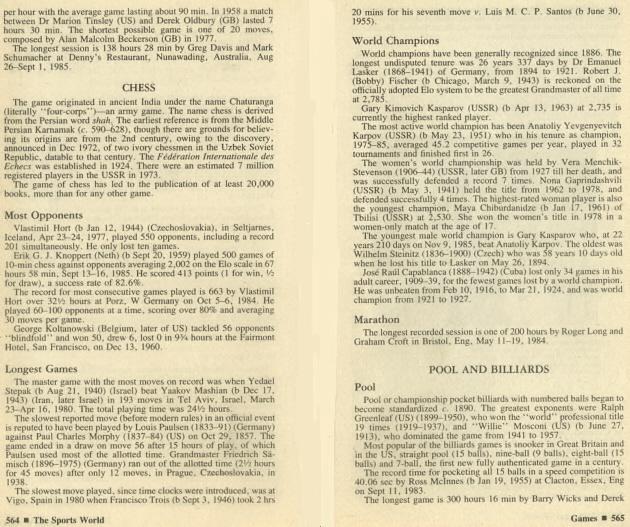
Weighing about four times as much, Guinness World Records 2012 has one entry on chess (‘Most games of chess played simultaneously in one location’), with two photographs (page 154).
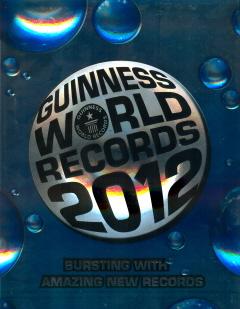
Elsewhere (page 265) there is an entry on ‘the first Chess Boxing World Championship’, referring to an event in 2003. At least that is relegated to a section headed ‘Sporting Madness’, alongside reports on the Winkle Spitting World Championship, the UK Mobile Throwing Championships and the Mashed Potato Wrestling Championships.
7282. The original signatories of the Fédération Internationale des Echecs (C.N. 7251)
Luc Winants (Boirs, Belgium) notes that 15 countries (including Finland) were listed in an article on pages 56-59 of the Bulletin de la Fédération Belge des Echecs, December 1924. The complete article has been added to Chess: The History of FIDE.
7283. Réti study
When Mr Winants forwarded the FIDE material mentioned in the previous item he included the cover page of the December 1924 issue of the Bulletin de la Fédération Belge des Echecs:

We are intrigued by the Réti study, which is not included in the standard books and databases. It is, though, similar to a composition (‘Verbessert nach Tijdschrift 1922’) given on page 26 of Richard Réti: Sämtliche Studien (Mährisch-Ostrau, 1931), the sole difference being that the rook is on f2.
Readers are invited to ponder the study in the Belgian magazine, and a future item will revert to this topic.
7284. Brilliancy-prize game
Seldom is a brilliancy-prize game in a master tournament almost wholly forgotten, but Eduardo Bauzá Mercére (New York, NY, USA) draws attention to this miniature on page 61 of the March 1912 American Chess Bulletin:
Hersz/Gersz Rotlewi – Efim BogoljubowWarsaw, 1910
Old Indian Defence
1 d4 Nf6 2 c4 d6 3 Nc3 Nbd7 4 e3 e5 5 Bd3 g6 6 Nge2 Bg7 7 O-O O-O 8 f4 Qe7 9 f5 Nb6 10 Ng3 Bd7 11 d5 e4 12 Be2 c6 13 a4 cxd5 14 a5 Nxc4 15 Nxd5 Nxd5 16 Qxd5 Nxb2
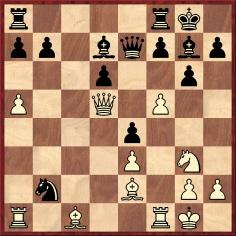
17 f6 Bxf6 18 Rxf6 Qxf6 19 Nxe4 Qg7 20 Qxd6 Be6 21 Qe7 Qe5 22 Nf6+ Kg7
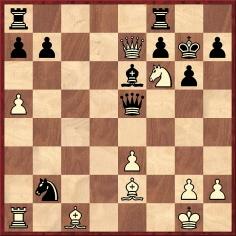
23 Ng4 Rae8 24 Qxf8+ Kxf8 25 Nxe5 Resigns.
We note that the score was given on pages 104-105 of volume five of Arcymistrzowie, mistrzowie, amatorzy ... by Tadeusz Wolsza (Warsaw, 2007). Mr Bauzá Mercére observes that the crosstable of the Warsaw, 1910 tournament, which Rotlewi won jointly with Rubinstein, is on page 178 of Akiba Rubinstein: Uncrowned King by John Donaldson and Nikolay Minev (Seattle, 1994).
7285. Cartoons and
comic strips
Morten Hansen (Frederiksberg, Denmark) points out another chess-related comic strip, dating from the early 1970s. Its Danish title is ‘Skak’, but the story originally appeared in Spanish, the artist being Esteban Maroto. The English version, ‘Chess’, was first published in issue 41 of the magazine Eerie in 1972.
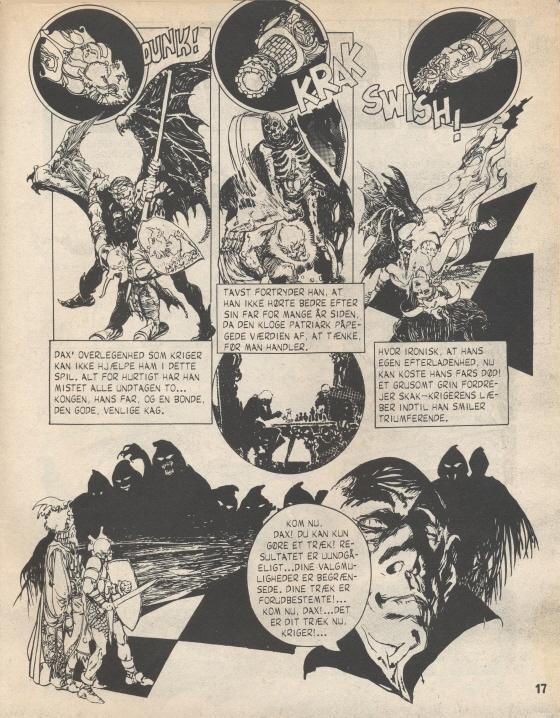
The plot is summarized by Mr Hansen as follows:
‘Dax the warrior is challenged to a game of chess by a sorcerer who calls himself the chessmaster of the universe. The sorcerer explains that Dax will have the white pieces and that they will consist of Dax’s dead friends and relatives. They have been called back from the long night of death, but if Dax loses the game they will be gone forever. The black pieces consist of various monsters and demons. Dax is no match for the sorcerer, and the white pieces fall one by one until finally Dax’s father, acting as the white king, is cut down by the black queen. The enraged Dax breaks the rules of the game, slaying the black queen for revenge, whereupon the equally enraged sorcerer expels Dax, who wakes up next to the severed head of his father.’
7286. Moscow, 1935 (C.N. 7266)
Karel Mokrý (Prostějov, Czech Republic) informs us that he investigated the Moscow, 1935 photograph in the 1980s and drew up the key given below:

Mr Mokrý also mentions an article which he has written on the two variations of the Russian-language tournament book and the subsequent removal of Krylenko’s name and contribution. See under ‘Moscow 1935’ in the ‘Collector’s Corner’ of our correspondent’s webpage.
7287. Literary fund (C.N. 7277)
Further to the item about Bernhard Horwitz’s application for support from the Royal Literary Fund, John Townsend (Wokingham, England) writes:
‘It seems that Clement Mansfield Ingleby, a Shakespeare critic and chessplayer, had some influence in such matters. He held a position at the Royal Society of Literature, 4 St Martin’s Place, and he wrote to the Prime Minister, Disraeli, immediately after Staunton’s death, seeking a pension on the Civil List for Staunton’s widow. (See page 167 of my recent book Notes on the life of Howard Staunton.)
One way of dealing with such requests was via a grant from the Royal Bounty, which was one of the classes of the Civil List, being at that time under the administration of the Prime Minister. In Mrs Staunton’s case, a lump sum of £200 was granted. (See Records of the Royal Bounty (1868-1880), National Archives, PMG 27/62, page 136 (1874).) If Horwitz’s application followed a similar course, one might hope to find an entry during 1872 or 1873 in the same group of records at the National Archives.’
7288. Gossip’s application

G.H.D. Gossip
Hans Renette (Bierbeek, Belgium) provides details of another chess figure who made an application for support from the Royal Literary Fund: G.H.D. Gossip.
Giving his full name as George Hatfeild Dingley Gossip, he stated on his application form that he was a widower with three children. ‘Present means and sources of income: Extremely precarious derived from magazine writing, occasional, though very rare newspaper articles and literary work. No salary, annuity or pension whatsoever.’ His income over the past year had been under £65.
The file contains three letters from Gossip to the Fund, dated 3 and 14 December 1890 and 9 January 1891.
Two extracts from the first letter:
‘Although I am an Englishman and a British subject, according to International Law, having been brought up since babyhood and educated in England; and although my father’s name – that of an Englishman born in [illegible] – is to be found in Burke’s Dictionary of the Landed Gentry, under De Rodes of Barlborough and the Hatfeild and Gossip families, I was born in America; but on the death of my mother, my father brought me to England, when only three years old, and I was brought up at the Barlborough Hall of Washington Irving, who was the guest of my late Uncle and Aunt, Mr and Mrs Reaston Rodes. Barlborough Hall is mentioned at great length by Washington Irving on page 164 of his Abbotsford and Newstead Abbey, where he gives a long account of the Christmas festivities …’
‘I have been wonderfully unfortunate, and am a confirmed fatalist. I am quite convinced that the will of my aunt, Mrs Reaston Rodes, who idolized me, was burnt by a cousin a few hours after her death, and I was thus defrauded of £10,000. ... Then my Father, Uncle and their three surviving sisters were ruined utterly in a great lawsuit, just when I could have taken a scholarship of £60 a year at Oxford from St Mary’s College, Windermere, where I was educated; so that I never had a penny except what I could earn by my own unaided exertions, and was unable to go to Oxford.
I was subsequently defrauded of a large sum of money, by a dishonest solicitor, in whom I [illegible] implicit confidence, at a time when I was too ill to attend to my affairs.’
The third letter concerned his chess writings. The underlinings are Gossip’s own.
‘20 Alfred Place
Bedford SquareTo the Committee of the “Royal Literary Fund”
Gentlemen,
With regard to my application, I beg to state that I was obliged to publish privately, through a Yorkshire printer, the first edition of my Theory of the Chess Openings, because no London publisher would entertain it, notwithstanding the fact that it was declared the best work of its kind in any language by the entire British, American and Continental Chess Press, that I had had Royal patronage, £60 worth of subscriptions, by signed orders for copies, and that my previous work – The Chess Players’ Manual, (published by Routledge five years before in 1874, and most favorably reviewed by all impartial or competent critics) had had a good sale and has since had three Editions. I was foolish enough to sell outright to Messrs. Routledge the entire valuable copyright of this book of over 800 pages which occupied my time for nearly two years for the miserable sum of £70; and although Routledge has, I am informed on good authority, made thousands by my work, he will not give me a penny, and his shabby conduct towards me has been publicly commented on in America in the columns of the Boston Post.
I have rendered great services to chess literature, and the Huddersfield College (now the British) Chess Magazine, in reviewing my Chess Manual, said that a deep dept of gratitude was due to Mr Gossip for this splendid addition to the Library of the Chessplayer (sic) …
Such are the services I have rendered at Chess and Chess literature! Yet notwithstanding this and my high position in the Chess World as a player, (having played some of the most brilliant games on record) as well as a theorist, (for I have won many prizes in public Tournaments and matches, and have just won third prize in Divan Tourney), I can obtain no chess Editorship and am literally left out in the cold.
The necessity of my application is evidently by the fact that I am utterly without resources, my sight is affected and I suffer from hernia and other ailments. For two days this week I was absolutely starving. I have no relations living, to whom I could apply, except distant ones whom I cannot trace, although I have children.
This will doubtless be sufficient, without my worrying you with long explanations and details of my extraordinary misfortunes and misery.
I remain,
Gentlemen,Yours obediently,
G. Hatfeild D. Gossip.’
The form indicates that on 14 January 1891 Gossip’s application was refused.
7289. Moscow, 1936
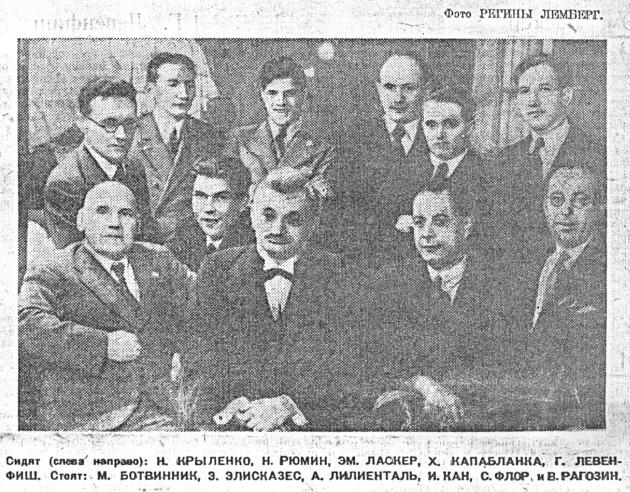
The above is reproduced from a photocopy of a picture in the Moscow, 1936 tournament bulletin (published by 64), 13 June 1936, as well as on page 1 of 64, 16 June 1936. Can a copy of good quality be obtained?
The same question applies to over a dozen pictures featuring Capablanca which appeared in Soviet chess magazines in the 1920s and 30s. See Photographs of Capablanca.
7290. Alekhine at
the piano
Christian Sánchez (Rosario, Argentina) notes an interview with Alekhine by Carlos M. Portela on page 8 of the magazine Caras y Caretas, 4 September 1926:
The accompanying photograph:
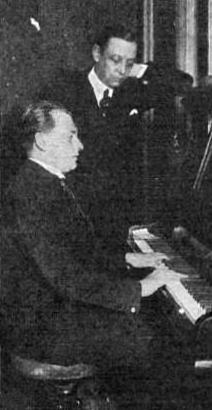
Mr Sánchez highlights some points from the article:
- Alekhine has successfully completed his studies in Paris.
- He comments on Nimzowitsch’s challenge to Capablanca: ‘This is too much.’
- On the world championship: ‘Gathering the 10,000 dollars is harder than winning ...’
- ‘The chess world considers that only Lasker and I can aspire to match the champion.’
- ‘I should like to realize my great ambition in Buenos Aires.’
- On his literary activity: ‘Because of my writing I was sentenced to death by the Cheka.’
7291. ‘Not publishable for legal reasons’
From a letter written by Tony Miles (3 May 1991) and included on pages 18-19 of the July 1991 CHESS:
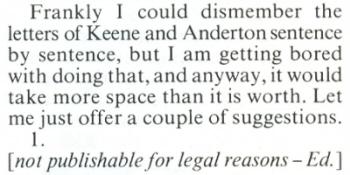
The excised suggestion can be viewed in Cuttings.
7292. Who?
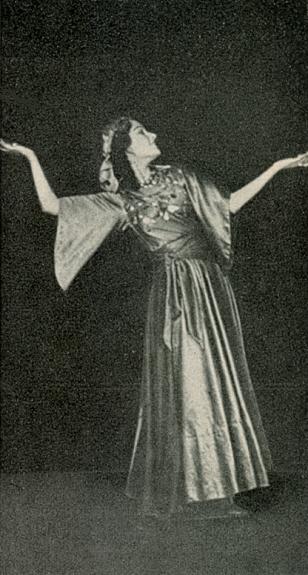
7293. Pensioners pawnpushing
This article by G.H. Diggle comes from page 29 of Chess Characters (Geneva, 1984), having originally appeared in the December 1977 Newsflash:
‘Every Autumn a Chess Match takes place which is not widely reported in the Press. We refer to the Annual 15-Board contest established in 1935, and played at Lloyds Bank, 71 Lombard Street between “Town” and “Country”, i.e. London Branches of the Bank versus “the Rest of England”. As the match is open to retired as well as present members of the Staff, the Town Team is usually graced by the presence of the Badmaster and other relics of a bygone age (30 years ago regarded as the flower of London Banks’ League Chess – now reduced to one disastrous match game per annum). For every year these worthies emerge from their park gates, totter up to Town, and are bowled over like ninepins by divers presumptuous youths from the North and Midlands – the products of that annoying upsurge of Chess among the young which has sprung in part from Fischer v Spassky and in part from too much chess education in our schools. The contest is ruefully accorded (by the defeated old stagers) such titles as “Pensioners Pawnpushing” or “The Old Boys’ Chess M.O.T.”.
In the case of the Badmaster, the result of the M.O.T. is invariably shattering. For his chess gets into a worse muddle as time goes on. His knowledge of the Openings, after 50 years’ fitful philandering, is now a confused labyrinth of dim passages and unfinished stairways, some rotten with age, and others (as soon as he has found his way about them) promptly pulled down and rebuilt by some disobliging authority. His “Practical Endgame Play” is possibly no worse than before – all through life he has enriched posterity with Rook and Pawn rubbish produced at the fag ends of Tuesday evenings in a smoke laden atmosphere at the rate of “six moves every 15 minutes thereafter”. But the Middle Game – “what a falling off is there!” His erstwhile combinative sparkle grows dim – the change of life is upon it – he never attempts a combination now – his suspicion is too strong for his analysis. In short (to paraphrase the great Henry Thomas Buckle) “The decline of genius is hard to bear – the decline of mediocrity is intolerable!” Yet the BM has much to be thankful for. In the first place, thousands of decrepit players are in the same boat, though they are making rather less noise about it. Again, if he has never succeeded in producing a presentable game, there is the proud consolation that no less a player than the late R.P. Michell once made the same claim.’
Regarding Michell, see G.H. Diggle’s article in C.N. 5061.
7294. MacDonnell v Amateur
From page 140 of the Westminster Papers, 1 January 1873:
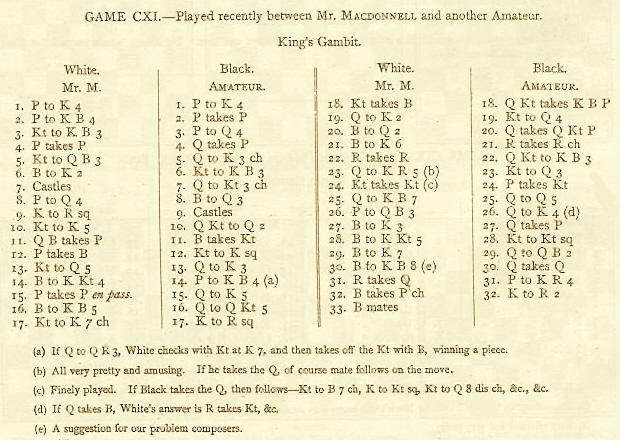
There would seem to be a glaring mistake/impossibility in the game-score, but how is it to be explained?
7295. Robert G. Wade (C.N.s 7269 & 7274)
Below is Wade’s complete entry on page 240 of Who’s Who in New Zealand (Wellington, 1951):
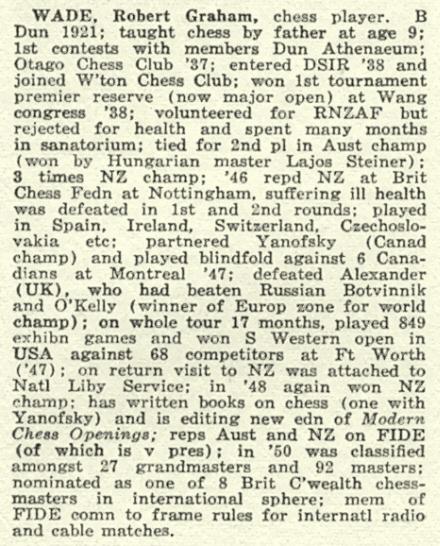
The bibliographical references may seem surprising at
first sight, but page vii of Chess the Hard Way!
by D.A. Yanofsky (London, 1953) acknowledged Wade’s
collaboration. On page v of the eighth edition of Modern
Chess
Openings (London, 1952) the Editor, Walter Korn,
related in detail the extent of the contribution by Wade.
7296. Tediouſneſs
The opening paragraph of the chapter on chess in The Compleat Gamester by Charles Cotton (London, 1674), page 51:
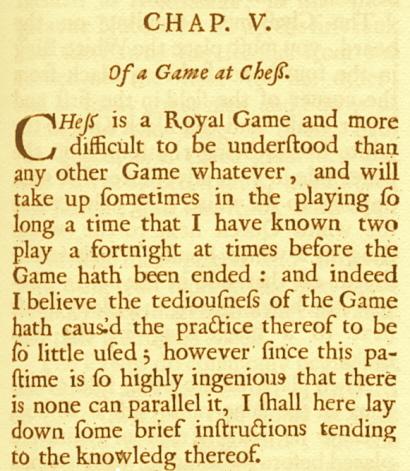
| First column | << previous | Archives [86] | next >> | Current column |
Copyright: Edward Winter. All rights reserved.